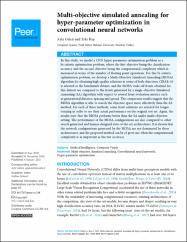Multi-Objective Simulated Annealing for Hyper-Parameter Optimization in Convolutional Neural Networks
Citation
GÜLCÜ, Ayla & Zeki KUŞ. "Multi-Objective Simulated Annealing for Hyper-Parameter Optimization in Convolutional Neural Networks", PeerJ Computer Science, 7.e338 (2021).Abstract
In this study, we model a CNN hyper-parameter optimization problem as a
bi-criteria optimization problem, where the first objective being the classification
accuracy and the second objective being the computational complexity which is
measured in terms of the number of floating point operations. For this bi-criteria
optimization problem, we develop a Multi-Objective Simulated Annealing (MOSA)
algorithm for obtaining high-quality solutions in terms of both objectives. CIFAR-10
is selected as the benchmark dataset, and the MOSA trade-off fronts obtained for
this dataset are compared to the fronts generated by a single-objective Simulated
Annealing (SA) algorithm with respect to several front evaluation metrics such
as generational distance, spacing and spread. The comparison results suggest that the
MOSA algorithm is able to search the objective space more effectively than the SA
method. For each of these methods, some front solutions are selected for longer
training in order to see their actual performance on the original test set. Again, the
results state that the MOSA performs better than the SA under multi-objective
setting. The performance of the MOSA configurations are also compared to other
search generated and human designed state-of-the-art architectures. It is shown that
the network configurations generated by the MOSA are not dominated by those
architectures, and the proposed method can be of great use when the computational
complexity is as important as the test accuracy.



















